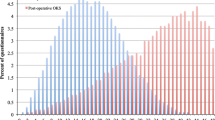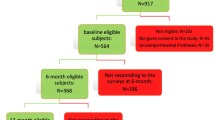Abstract
Purpose
Total knee arthroplasty (TKA) is usually effective, although not all patients have satisfactory outcomes. This assumes distinct recovery patterns might exist. Little attention has been paid to determine which patients have worse outcomes. This study attempts to distinguish specific recovery patterns using the Oxford knee score (OKS) during the first postoperative year. The secondary aim was to explore predictors of less favourable recovery patterns.
Methods
Analysis of patients in the Dutch Arthroplasty Register (LROI) with unilateral primary TKA. Data collected up to one year postoperative was used. To identify subgroups of patients based on OKS, latent class growth modeling (LCGM) was used. Moreover, multivariable multinomial logistic regression analysis was used to explore predictors of class membership.
Results
809 Patients completed three OKS during the first year postoperative and were included. LCGM identified 3 groups of patients; ‘high risers’ (most improvement during first 6-months, good 12-month scores 77%), ‘gradual progressors’ (continuous improvement during the first year 13%) and ‘non responders’ (initial improvement and subsequent deterioration to baseline score 10%). Predictors of least favourable class membership (OR, 95%CI) are EQ-5D items: VAS health score (0.83, 0.73–0.95), selfcare (2.22, 1.09–4.54) and anxiety/depression (2.45, 1.33–4.52).
Conclusion
Three recovery patterns after TKA were distinguished; ‘high risers', ‘gradual progressors' and ‘non responders'. Worse score on EQ-5D items VAS health, selfcare, and anxiety/depression were correlated with the least favourable ‘non responders’ recovery pattern.


Similar content being viewed by others
References
Baker P, Petheram T, Jameson S, Reed M, Gregg P, Deehan D (2012) The association between body mass index and the outcomes of total knee arthroplasty. J Bone Joint Surg Am 94:1501–1508
Baker PN, van der Meulen JH, Lewsey J, Gregg PJ, National Joint Registry for E, Wales (2007) The role of pain and function in determining patient satisfaction after total knee replacement. Data from the National Joint Registry for England and Wales. J Bone Joint Surg Br 89:893–900
Berlin KS, Parra GR, Williams NA (2014) An introduction to latent variable mixture modeling (part 2): longitudinal latent class growth analysis and growth mixture models. J Pediatr Psychol 39:188–203
Bourne RB, Chesworth BM, Davis AM, Mahomed NN, Charron KD (2010) Patient satisfaction after total knee arthroplasty: who is satisfied and who is not? Clin Orthop Relat Res 468:57–63
Dawson J, Fitzpatrick R, Murray D, Carr A (1998) Questionnaire on the perceptions of patients about total knee replacement. J Bone Joint Surg Br 80:63–69
Dowsey MM, Smith AJ, Choong PFM (2015) Latent Class Growth Analysis predicts long term pain and function trajectories in total knee arthroplasty: a study of 689 patients. Osteoarthritis Cartil 23:2141–2149
Dumenci L, Perera RA, Keefe FJ, Ang DC, Slover J, Jensen MP et al (2019) Model-based pain and function outcome trajectory types for patients undergoing knee arthroplasty: a secondary analysis from a randomized clinical trial. Osteoarthritis Cartil. https://doi.org/10.1016/j.joca.2019.01.004
Dutch Arthroplasty Register (in Dutch: LROI). Online LROI-Rapportage 2016: Blik op uitkomsten. https://www.lroi-rapportage.nl/media/pdf/PDF%20Online%20LROI-Rapportage%202016.pdf. Accessed 9 Jan 2020
Dutch Arthroplasty Register (in Dutch: LROI). Online LROI annual report 2017. https://www.lroi-rapportage.nl/media/pdf/PDF%20LROI%20annual%20report%202017.pdf. Accessed 11 Nov 2019
EuroQol G (1990) EuroQol–a new facility for the measurement of health-related quality of life. Health Policy 16:199–208
Halawi MJ, Allen DA, Baron S, Savoy L, Williams VJ, Cote MP (2018) Tobacco smoking independently predicts lower patient-reported outcomes: new insights on a forgotten epidemic. J Arthroplast. https://doi.org/10.1016/j.arth.2018.10.036
Jung T, Wickrama K (2008) An introduction to latent class growth analysis and growth mixture modeling. Soc Personal Psychol Compass 2:302–317
Kuperman EF, Schweizer M, Joy P, Gu X, Fang MM (2016) The effects of advanced age on primary total knee arthroplasty: a meta-analysis and systematic review. BMC Geriatr 16:41
Lindberg MF, Miaskowski C, RustoEn T, Rosseland LA, Cooper BA, Lerdal A (2016) Factors that can predict pain with walking, 12 months after total knee arthroplasty. Acta Orthop 87:600–606
Nagin DS (2005) Group-based modeling of development. Harvard University Press, Harvard
Nagin DS, Odgers CL (2010) Group-based trajectory modeling in clinical research. Annu Rev Clin Psychol 6:109–138
Page MG, Katz J, Romero Escobar EM, Lutzky-Cohen N, Curtis K, Fuss S et al (2015) Distinguishing problematic from nonproblematic postsurgical pain: a pain trajectory analysis after total knee arthroplasty. Pain 156:460–468
Rabin R, de Charro F (2001) EQ-5D: a measure of health status from the EuroQol Group. Ann Med 33:337–343
Ram N, Grimm KJ (2009) Growth mixture modeling: a method for identifying differences in longitudinal change among unobserved groups. Int J Behav Dev 33:565–576
Singh JA, Lewallen DG (2013) Medical and psychological comorbidity predicts poor pain outcomes after total knee arthroplasty. Rheumatol (Oxford) 52:916–923
Singh JA, O'Byrne M, Harmsen S, Lewallen D (2010) Predictors of moderate-severe functional limitation after primary total knee arthroplasty (TKA): 4701 TKAs at 2-years and 2935 TKAs at 5-years. Osteoarthritis Cartil 18:515–521
Tristaino V, Lantieri F, Tornago S, Gramazio M, Carriere E, Camera A (2016) Effectiveness of psychological support in patients undergoing primary total hip or knee arthroplasty: a controlled cohort study. J Orthop Traumatol 17:137–147
van de Schoot R, Sijbrandij M, Depaoli S, Vermunt JK (2017) The GRoLTS-checklist: guidelines for reporting on latent trajectory studies. Struct Equ Model Multidiscip J 451–467
van Steenbergen LN, Denissen GA, Spooren A, van Rooden SM, van Oosterhout FJ, Morrenhof JW et al (2015) More than 95% completeness of reported procedures in the population-based Dutch Arthroplasty Register. Acta Orthop 86:498–505
Vissers MM, Bussmann JB, Verhaar JA, Busschbach JJ, Bierma-Zeinstra SM, Reijman M (2012) Psychological factors affecting the outcome of total hip and knee arthroplasty: a systematic review. Semin Arthritis Rheum 41:576–588
Wickrama KAS, Lee TK (2016) Higher-order growth curves and mixture modeling with mplus: a practical guide.
Zale EL, Ring D, Vranceanu AM (2018) The future of orthopaedic care: promoting psychosocial resiliency in orthopaedic surgical practices. J Bone Joint Surg Am 100:e89
Zhao S, Chen F, Wang D, Wang H, Han W, Zhang Y (2019) Effect of preoperative smoking cessation on postoperative pain outcomes in elderly patients with high nicotine dependence. Medicine (Baltimore) 98:e14209
Acknowledgements
The authors would like to thank LROI for using the data. Moreover, we would like to thank the Van Rens Fonds for financially supporting this study.
Funding
This study was funded by the Van Rens Fonds Foundation (VRF2017-005), The Netherlands.
Author information
Authors and Affiliations
Contributions
JE performed data-analysis, he wrote and revised the manuscript for important intellectual content. BH supported data-analysis and critically reviewed the manuscript for important intellectual content. MM designed the study and critically reviewed the manuscript for important intellectual content. SV designed the study and critically reviewed the manuscript for important intellectual content and wrote the funding application. LS designed the study, provided data from the Dutch Arthroplasty Register (LROI) and critically reviewed the manuscript for important intellectual content. NM designed the study, supported data analysis and critically reviewed the manuscript for important intellectual content. JP designed the study, supported data analysis, critically reviewed the manuscript for important intellectual content and wrote the funding application. All authors approved the final version of the manuscript.
Corresponding author
Ethics declarations
Conflict of interest
S.B.W. Vehmeijer has a consultancy contract with Zimmer Biomet.
Ethical approval
Not applicable.
Informed consent
Not applicable.
Additional information
Publisher's Note
Springer Nature remains neutral with regard to jurisdictional claims in published maps and institutional affiliations.
Electronic supplementary material
Below is the link to the electronic supplementary material.
Rights and permissions
About this article
Cite this article
van Egmond, J.C., Hesseling, B., Melles, M. et al. Three distinct recovery patterns following primary total knee arthroplasty: dutch arthroplasty register study of 809 patients. Knee Surg Sports Traumatol Arthrosc 29, 529–539 (2021). https://doi.org/10.1007/s00167-020-05969-8
Received:
Accepted:
Published:
Issue Date:
DOI: https://doi.org/10.1007/s00167-020-05969-8




